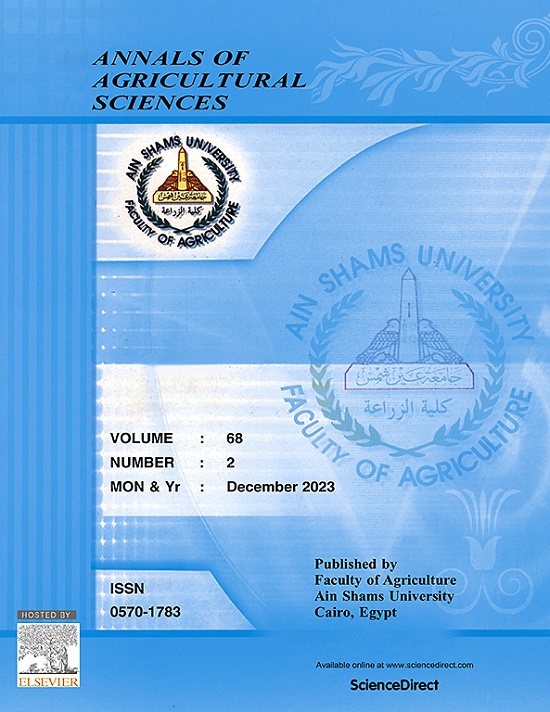Vertical hydroponic lettuce: Impact of organic nutrients on antioxidant phytochemicals
IF 3.2
2区 农林科学
Q1 AGRICULTURE, MULTIDISCIPLINARY
引用次数: 0
Abstract
Biofertilizers play an important role in sustainable agriculture as they are environmentally friendly practice. Hence, the present study was conducted to investigate and compare the performance of four organic-based nutrient solutions (NSs) from fish farm waste (NSB), humic acid (NSC) and (NSD), and plant source (NSE) with an inorganic fertilizer (NSA) as control on lettuce cv ‘Lollo bianda’ grown in a Nutrient Film Technique (NFT) Vertical hydroponic system. Plant growth parameters, yield, mineral content, phenolic content, antioxidant activity, and individual phenolic compounds have been identified and quantified in response to different NSs. Among the organic-based NSs used, NSB and NSE produced a slightly lower crop yield (185 and 189 g/plant) than the inorganic NSA (211 g/plant). Organic NSs resulted in lower leaf nitrate levels in the lettuce leaf (9.5–15 mg kg−1 DW) as compared to the control (189 mg kg−1 DW). Notably, Organic NSs gave higher phenolic content and antioxidant activity, with the highest level in NSC and NSD (96.65 and 98.51 mg g−1, respectively) than the control (68.48 mg g−1). Chlorogenic acid, trans-ferulic, and benzoic acid levels were significantly higher, while vanillic acid and 4-hydroxy benzoic acid levels were lower in organically grown plants than those of inorganic NS. Overall, the findings provided evidence that the NS has a direct impact on the phenolic compounds content and their profile which may elucidate the mechanism of the plant response to NSs from different sources. The study offers a promising avenue for sustainable hydroponics and agricultural practices in arid environments.
垂直水培莴苣:有机养分对抗氧化植物化学物质的影响
生物肥料对环境友好,在可持续农业中发挥着重要作用。因此,本研究以养鱼场废弃物有机营养液(NSB)、腐植酸(NSC)和腐植酸(NSD)以及植物源营养液(NSE)和无机肥料(NSA)作为对照,对垂直水培系统中种植的莴苣“Lollo bianda”进行了研究和比较。植物的生长参数、产量、矿物质含量、酚类物质含量、抗氧化活性和单个酚类化合物已被鉴定和量化,以响应不同的NSs。在使用的有机基氮氧化物中,NSB和NSE的产量(185 g/株和189 g/株)略低于无机氮氧化物(211 g/株)。与对照(189 mg kg - 1 DW)相比,有机氮素导致生菜叶片硝酸盐含量(9.5-15 mg kg - 1 DW)较低。有机NSs具有较高的酚类含量和抗氧化活性,其中NSC和NSD的酚类含量最高(分别为96.65和98.51 mg g - 1),高于对照(68.48 mg g - 1)。有机土壤中绿原酸、反式阿魏酸和苯甲酸含量显著高于无机土壤,香草酸和4-羟基苯甲酸含量显著低于无机土壤。综上所述,研究结果表明,植物对不同来源的植物对植物酚类化合物的含量和分布有直接影响,这可能有助于阐明植物对不同来源的植物酚类化合物的反应机制。该研究为干旱环境下的可持续水培和农业实践提供了一条有希望的途径。
本文章由计算机程序翻译,如有差异,请以英文原文为准。
求助全文
约1分钟内获得全文
求助全文
来源期刊

Annals of Agricultural Science
AGRICULTURE, MULTIDISCIPLINARY-
CiteScore
12.60
自引率
0.00%
发文量
18
审稿时长
33 days
期刊介绍:
Annals of Agricultural Sciences (AOAS) is the official journal of Faculty of Agriculture, Ain Shams University. AOAS is an open access peer-reviewed journal publishing original research articles and review articles on experimental and modelling research at laboratory, field, farm, landscape, and industrial levels. AOAS aims to maximize the quality of the agricultural sector across the globe with emphasis on the Arabian countries by focusing on publishing the high-quality applicable researches, in addition to the new methods and frontiers leading to maximizing the quality and quantity of both plant and animal yield and final products.
 求助内容:
求助内容: 应助结果提醒方式:
应助结果提醒方式:


